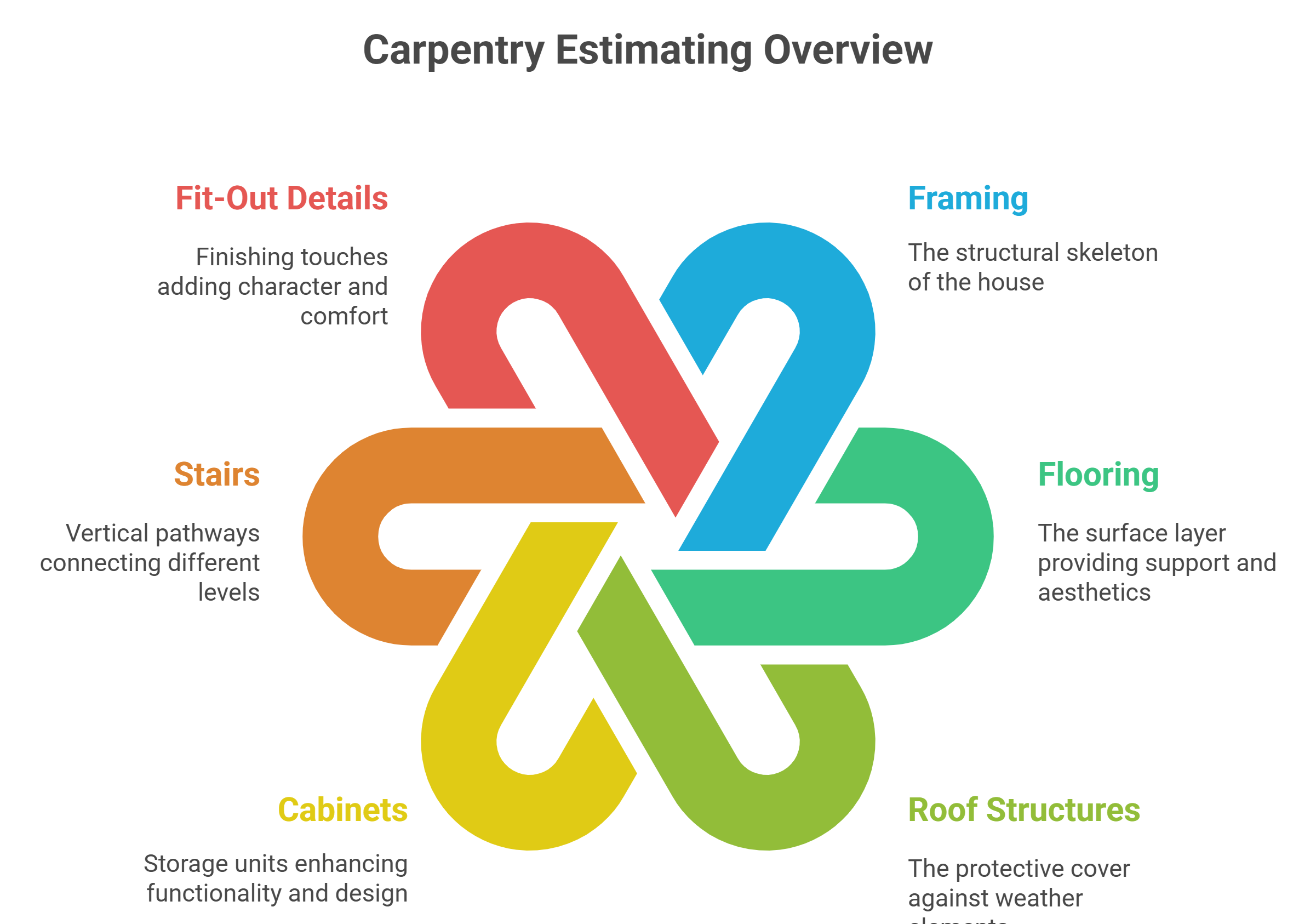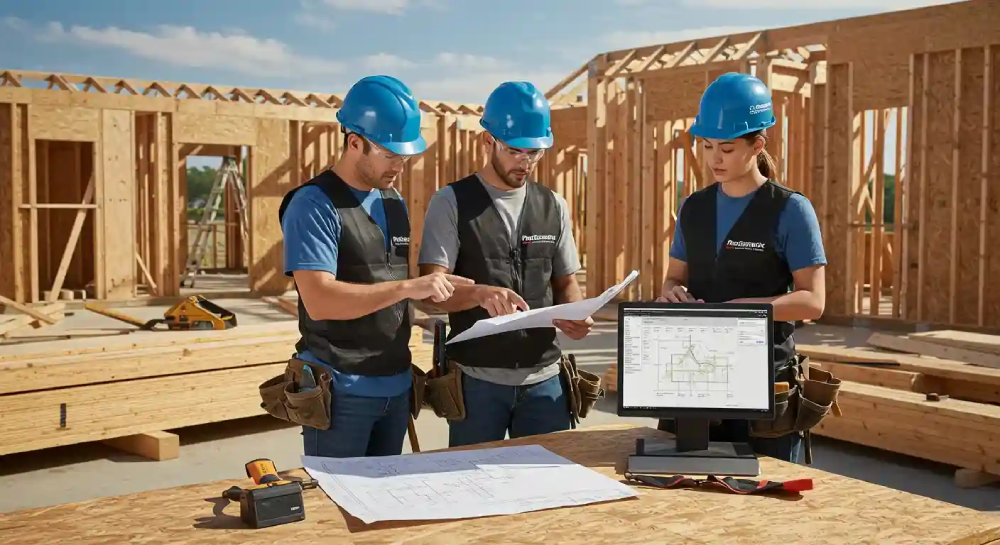Effective carpentry estimating underpins successful Australian construction by delivering precise budgets, streamlined schedules, and superior quality. It integrates seamlessly with trades like electrical estimating, forming a cornerstone of broader Construction Trade Estimating. For instance, with labour costs rising 4.1% according to ABS data, accurate estimates prevent overruns, ensuring projects stay viable and coordinated across all phases.
Where Carpentry Estimating Is Needed in a House?

From foundations to final touches, carpentry estimating guides residential builds by balancing structural integrity with aesthetic appeal. It tightens cost control during framing through to cabinetry, helping homeowners avoid surprises and maximise value in every square metre of their space.
Framing, Flooring, and Roof Structures
Starting with the skeleton of your home, precise carpentry estimating for timber framing and roof trusses guarantees long-term stability while curbing unnecessary expenses. By factoring in site-specific loads and wind ratings, estimators can optimise material use, often slashing overruns that plague rushed plans.
Beyond framing, standardised data for flooring areas sharpens pricing and minimises waste. In Australian homes, this approach can achieve up to 18% less timber waste, as noted in recent Green Building Council reports, fostering sustainability without compromising on durability or finish quality.
Cabinets, Stairs, and Fit-Out Details
Detailed carpentry estimating for custom joinery like cabinets and stairs uncovers hidden costs early, allowing for smarter material choices and smoother installations. This prevents budget creep in the home’s finer elements.
- Overlooking hinge and hardware specifications in kitchen cabinets.
- Ignoring balustrade compliance in staircase designs.
- Underestimating trim profiles for door and window architraves.
Finish carpentry often accounts for 20-30% of total woodwork costs, highlighting why thorough estimates pay off in polished results.
Main Factors That Shape Carpentry Costs
Key elements like materials, labour, and site challenges directly influence carpentry estimating outcomes in Australian projects. Small residential jobs might see 12-15% cost swings based on timber quality and worker efficiency, demanding careful analysis to keep bids competitive and realistic.
Material Choice and Timber Availability
Selecting the right timber, whether native hardwoods or certified imports, drives carpentry estimating precision amid market shifts. Sustainability labels like FSC add value but can inflate prices, especially with import fluctuations affecting supply chains.
- Local pine: $200-300/m³, readily available with lower transport costs.
- Imported merbau: $400-600/m³, durable but prone to 10-20% price hikes from tariffs.
- Engineered timber: $250-450/m³, eco-friendly yet sensitive to moisture standards.
Hardwood imports climbed 6.2% in 2024, per Australian Bureau of Statistics, underscoring the need for flexible sourcing strategies.
Labour Efficiency and Project Complexity
Productivity in carpentry estimating hinges on metrics like square metres per hour, where national averages hover around $75/hour for Sydney carpenters. Efficient teams reduce total outlay by aligning skills with tasks, but overlooking training gaps can erode margins.
Complex designs, such as curved staircases or restricted urban sites, extend installation times and inflate contingencies in carpentry estimating. These scenarios often require 20-30% more hours, emphasising the value of site surveys to anticipate access hurdles and maintain workflow.
Proven Methods for Carpentry Estimating
Blending time-tested techniques with modern tools elevates carpentry estimating from guesswork to reliable forecasting. Quantity take-offs paired with real-world cost benchmarks allow builders to predict expenses accurately, adapting to Australia’s variable material markets and regulatory demands.How to Quote Carpentry Jobs: A Step-by-Step Guide – Invoice Fly
Manual vs Digital Take-Off Approaches
Shifting from hand-measured blueprints to software-driven models transforms carpentry estimating speed and detail. Digital options catch errors that manual methods might miss, though both demand a keen eye for project nuances.
- Manual: Affordable, tactile insight; but time-intensive and error-prone.
- Digital: Faster scaling, integrated BIM; yet requires training and tech investment.
- Hybrid: Best accuracy; combines intuition with automation for complex jobs.
Australian benchmarks show digital take-offs cut estimating time by 35%, boosting efficiency in competitive tenders.
Using Historical Data for Cost Accuracy
Drawing from completed projects refines carpentry estimating by establishing realistic baselines for timber and labour. This data-driven habit spots trends, like seasonal price dips, ensuring bids reflect actual field conditions without inflated buffers.
| Project Type | Average Timber Cost/m² | Labour Hours/m² |
|---|---|---|
| Residential | $280 | 1.8 |
| Commercial | $340 | 2.4 |
| Renovation | $310 | 2.1 |
Best Carpentry Estimating Software in Australia
Digital tools streamline carpentry estimating, offering builders quick calculations and visual aids tailored to local standards. Around 60% of mid-sized firms now rely on them for tighter cost control, integrating seamlessly with project management workflows.Carpentry Estimating Software | Buildxact US
- CostX: Excels in detailed quantity surveying with BIM compatibility for precise take-offs.
- Buildxact: User-friendly for small teams, focusing on cloud-based quoting and material lists.
- Cubit: Strong in 3D modelling, ideal for visualising complex joinery before costing.
- PlanSwift: Fast drag-and-drop interface, perfect for on-screen measurements in renovations.
Final Insights on Smarter Carpentry Estimating
Mastering carpentry estimating fuses accuracy with foresight, aligning Australian builds on budget and timeline. By leveraging data, software, and trade insights, professionals enhance coordination, much like in electrical estimating, elevating overall Construction Trade Estimating standards for enduring project success.


